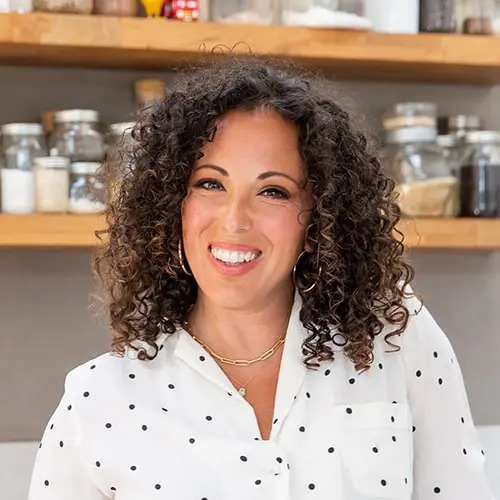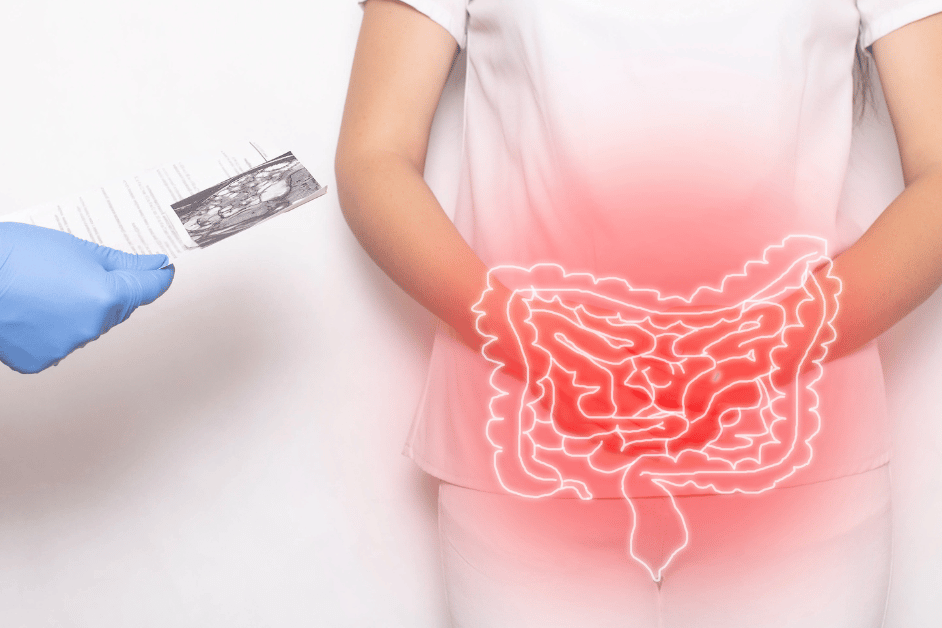Catherine was a 42-year-old small-business owner who came to me struggling with constipation, bloating, gas, intestinal cramping, and painful bowel movements—almost every symptom of IBS. She was exhausted after years of suffering with these symptoms, and felt lingering anxiety most of the time, not knowing when her gut was going to act up and prevent her from being able to run her business, and enjoy time with her daughter who was about to graduate and leave for college.
She first noticed these symptoms around the same time that she’d gone through a very stressful period of building and then selling a house that she’d thought she would be calling home. During this time, she started having daily back pain from the stress. She was taking a lot of ibuprofen to manage the pain, when she started to experience a burning feeling in her stomach as though she had an ulcer.
Her doctor diagnosed her with gastritis caused by the ibuprofen, and recommended taking Prilosec, a drug that blocks acid production. While the Prilosec did help relieve the burning discomfort in her stomach, she found that the pain returned every time she tried to come off of the drug. Worse yet, After taking it for a year, she started to notice other digestive symptoms like bloating, gas, pain, and constipation, and stopping the Prilosec didn’t make these symptoms any better. That’s when she came to see me.
IBS is very common, affecting up to 15% of the population, although many people with symptoms have not been medically diagnosed, so these numbers may actually be an underrepresentation. Sufferers commonly experience gas, bloating, abdominal pain or cramping, constipation, loose stool or diarrhea, and may notice symptoms come and go, or change over time.
What is IBS….?
IBS is not actually a disease. Rather, it is a syndrome, meaning that someone can be given a diagnosis of IBS if they have a cluster of symptoms that show up regularly within a specific period of time. While the exact cause is unknown, it is thought to occur because of problems with the way the gut, brain, and nervous system interact. Recent research shows that most cases of IBS have multiple factors involved, such as changes in gut motility, small-intestinal bacterial overgrowth, low-grade chronic inflammation, and hypersensitivity to pain in the nerves of the intestines. There are predictable triggers for IBS, and the root cause can be different in each person.
If you struggle with symptoms of IBS, there are a few simple things that you can do right away:
Diet
There are certain foods that can be a trigger for IBS symptoms, the most common ones being Gluten, grains, dairy, soy, sugar, and processed foods, although there can be many others. Many people find that by going on a whole-foods paleo diet, many or all of their symptoms resolve. If you haven’t already, going on a 30-day clean Paleo diet, eliminating the above mentioned foods, as well as legumes, can be a safe and easy place to start.
While this step alone can be the magic bullet in some people, other people may get relief by further refining the Paleo diet and following a low FODMAP diet. FODMAPS are naturally occurring compounds found in the carbohydrates in specific foods that can be fermented by gut bacteria. Since many cases of IBS are caused by having dysbiosis (the wrong kinds of bacteria) in the gut, or by SIBO (small intestinal bacterial overgrowth–too many bacteria in the wrong place), temporarily restricting foods that feed these bacteria can help.
The idea with the Low FODMAP diet, as with other diets that restrict fermentable foods (such as SCD, GAPS, and Low Fermentation Potential Diets) is to starve out the undesirable bacteria that are causing the symptoms to occur.
You should notice improvement within several weeks, if these approaches are going to benefit you. However, I don’t recommend following a Low FODMAP diet long term, because all of the beneficial bacteria that form a healthy microbiome need these fermentable compounds for food as well.
It is also common for people following a low FODMAP diet to not get enough fiber content in their diet, (which can cause additional gut symptoms) so it is important to include the low FODMAP foods that contain fibers (such as blueberries, oranges, carrots, potatoes, eggplant, nuts and seeds, zucchini, cucmbers, green beans, tomatoes, dark leafy greens, and grapes). Low FODMAP fibers ferment more slowly and are less likely to cause digestive symptoms.
If you get symptomatic improvement by removing high FODMAP foods from your diet, it suggests that you may have SIBO or dysbiosis at the root of your symptoms, and you may need to use other approaches in combination with diet, in order to get full resolution of your IBS. Again, FODMAPs are not the cause of your IBS, but rather a sign that something living in your gut, that likes to eat FODMAPS for food, is.
Strategic Supplements
Try taking Digestive enzymes and HCL
Digestive Enzymes are produced by the pancreas, and are used to break down the carbohydrates, fats and proteins that we eat. This not only makes them easier for us to digest and absorb for nutrition, but also prevents less-broken-down starches from making their way into the small intestine, where they are the perfect fuel for feeding bacteria there, causing or worsening SIBO.
Heavy alcohol consumption, gallbladder dysfunction, parasites and other digestive infections, and chronic stress or Adrenal Fatigue are a few of the things that can deplete enzyme production. Enzymes are very safe to use and can turn symptoms around overnight in some people, especially gas, bloating, and diarrhea. There are several brands that I’ll recommend to clients, including Dipan 9 by Thorne, Pure Pancreatic Enzymes by Pure Encapsulations, or PanZyme pH by Xymogen. Different people need different dosages to get results, typically ranging from 1-4 capsules per meal. Start low and increase over several meals to find your dosage.
Betaine HCL is a supplement that increases the amount of hydrochloric acid in the stomach. HCL is required for proper digestion of proteins and absorption of amino acids, as well as for availability of vitamin B12 and minerals such as magnesium and iron. One of the things that stomach acid does is to activate pepsinogen into the enzyme pepsin, which helps to break down proteins, which is why I recommend making sure that your HCL supplement also contains pepsin.
Stomach acid is also essential for killing off potentially pathogenic organisms in the food we eat, preventing infections, and for regulating emptying of the stomach into the small intestine.
But is it safe for me to swallow acid in pills?
For most people, HCL supplementation is extremely safe. The lining of your stomach is at least 1mm thick (which may not sound like much, but compared to many other linings in the body is quite sturdy!) and is designed to withstand exposure to extremely acidic secretions. But there are a few people who should not take Betaine HCL without supervision:
- People taking corticosteroids
- People taking NSAIDS such as aspirin, ibuprofen (advil, motrin), and others
- People with active gastritis or ulcers
These drugs and conditions can damage the lining of the gut, and HCL can cause risk of bleeding or ulceration.
That said, in most people the risks of eating food while having low stomach acid levels outweigh the risks of taking supplemental stomach acid. If you are concerned about trying HCL, it is always a good idea to use the supervision of a trained practitioner.
How much should I take?
Just as with digestive enzymes, each person has a unique dose that will give them the support they need. The only way to figure it out is to experiment. A common pitfall I’ve seen is people not taking a high enough dose to get benefit. Here’s how to figure it out:
- 10-15 minutes before a meal that will contain protein (at least 4-6 ounces), take 1 capsule of Betaine HCL (the highest dose per cap that I use is 520 mg/cap).
- Eat your meal as usual, and take note of any sensations in the stomach area, either before you eat, during or after the meal. Most people report a feeling of warmth, pressure, or mild burning.
- Use this dose for 1-2 more meals, and then increase to 2 caps before the next protein-containing meal. Again, note any sensations.
- Increase number of capsules, in this manner, until some warmth or mild discomfort is noticed. When this occurs, reduce capsule dosage by 1 cap, and keep that dosage moving forward. If you noted warming at 5 caps, your dosage for most meals should be 4 caps. This amount may shift a little depending on the amount of protein or type consumed; if you eat a 6 ounce steak, you will need more than if you eat 2 scrambeled eggs.
If you experience discomfort at any point, you can quickly neutralize the HCL by mixing ½ teaspoon of baking soda in a cup of water and sipping it. This should stop any pain or discomfort.
If you notice burning even at one capsule, it is likely that you have thinning of the stomach lining, and should avoid HCL until you have taken steps to heal this to some extent. People with thinning of the stomach lining (atrophic gastritis) can usually tolerate digestive bitters tincture, apple cider vinegar in water, or lemon juice in water before meals, and these will all naturally help increase stomach acid in a more gentle way.
Add probiotics
There have been many clinical trials run on the effect of combination probiotics containing Lactobaccilus and Bifidus strains with IBS patients, all of which showed improvement of symptoms in a large percentage of the participants. Many patients showed noticeable reduction in gas and bloating, and a reduction in diarrhea or constipation depending on which they had predominantly. The products used in these studies generally contained a blend of the following strains:
- L Acidophilus
- L casei
- L plantarum
- L bulgaricus
- L helveticus
- B longum
- B infantis
- B breve
Some people with SIBO, or with histamine reactivity, don’t tolerate D-lactate forming probiotics (many of lactobaccilus strains fall into this category) well. If eating fermented foods like sauerkraut or yogurt worsens our symptoms, you may fall into this category. In these cases, I suggest trying either soil-based or spore-forming organisms, which are generally well tolerated by people with both SIBO and histamine issues. The two products that I use most frequently are MegaSporeBiotic and Prescript Assist.
My other favorite probiotic, Saccharomyces boulardii, is actually a beneficial yeast. While adding yeast to your gut may sound like a bad idea, since yeast overgrowth like candida can be a trigger for many digestive problems, S. Bouarldii is non-invasive and will complete with bacteria and other fungi in the small and large intestine. This means that in combination with other approaches, S boulardii can help crowd out SIBO and allow for restoration of a thriving microbiome.
Lifestyle and Stress Management
While not the most obvious solution, focusing on getting enough good quality sleep can profoundly improve IBS symptoms.
One of the causal factors in IBS is disruption of the migrating motor complexes, or MMC. These are electrical signals that trigger peristaltic waves that sweep through the intestine when we are fasting (when we are sleeping, or when we have gone more than 4 hours without eating). They help to sweep undigested food particles through the small intestine and into the large intestine, which prevents food from hanging around to long, allowing bacteria to ferment it and colonize the small intestine.
Restoring the MMC is very important in treating IBS, and in preventing SIBO regrowth after treatment, and it is largely regulated by our circadian rhythms and by the hormone melatonin. In fact, studies have shown that motility is directly proportionate to depth of sleep. The production of melatonin by our pineal gland is dependant on light and dark cycles. So, getting enough hours of sleep per day, and sleeping during hours where it is dark out help to maintain our circadian rhythms. Conversely, lack of sleep, sleep disturbance, and shift work can provoke IBS. Aim to get a minimum of 7, but more optimally 8 full hours of sleep—this may be something you have to schedule and prioritize as much as you would a business meeting! Avoid exposure to bright lights and blue light (from digital screens) after dark, as these shut down our melatonin production.
Stress also provokes IBS symtpoms, so minimizing stress wherever possible is also important. While some things in life that cause stress are outside of our control, there are many choices we can make in our day to day lives that can lower stress or adapt the way we respond to stressors. While this is a topic too large to explore here, a few quick ways to lower stress are:
- Avoid multitasking and concept shifting. Focusing on one task at a time fosters a sense of calm.
- When possible, consider saying “No” more often, when asked to take on new projects or roles.
- Practice yoga, in a class setting, or even for 10-15 minutes daily at home. There are hundreds of great apps and videos available online that offer short sessions of all levels.
- Even 10 minutes a day has been shown to lower stress, raise quality of life, and lower inflammation. Some of my favorite apps for helping people get started are www.headspace.com, www.buddhify.com, and www.calm.com.
- Practice Gratitude—shifting your focus to anything in your life that you appreciate, or finding something about the present moment (or person you are interacting with) that you appreciate, never fails to shift our internal and external environment for the better.
Fine-tuning your diet, adding a few targeted supplements, and taking stpes to actively manage stress can solve or greatly reduce frustrating symptoms of IBS for many people. If you try these approaches, and are still struggling with gas, bloating, diarrhea, or constipation, I suggest working with a trained practitioner to run some testing to find the root cause of your issues.
The most important testing to run for IBS:
- A lactulose breath test for SIBO. Up to 84% of IBS cases may be involve SIBO. The above approaches can help with symptoms of SIBO, but won’t resolve in more severe cases on their own.
- Stool testing for parasites, yeast/fungal overgrowth, or dysbiotic bacteria. These pathogenic organisms can all cause inflammation, disrupted motility, gas, bloating, pain, diarrhea, and constipation. You can have 1 or more parasites, and also have SIBO, so it is best to test for both, rather than just testing for one or the other.
If you need help with IBS, click here to set up a free 15-minute consult with me!
Catherine noticed improvement right away when she started taking a strong digestive enzyme and HCL w/pepsin with meals. At her second appointment, we reviewed her lab tests, which showed that she had a parasite called Enodolimax Nana, as well as methane-dominant SIBO.
After doing treatments for both of these digestive infections, Catherine took pro-kinetic supplements to restore her motility, gut repair supplements to heal leaky gut, and probiotics, while waiting for her follow-up retesting.
Although she felt much better, and her constipation had almost completely resolved, her retest showed that she had 2 types of fungal overgrowth that her initial testing hadn’t picked up. We treated her using an anti-yeast/fungal protocol, and within 2 months, Catherine’s bloating had resolved, she had regular daily bowel movements, and no more digestive pain, as long as she avoided gluten exposure.
At the Reverse-Age Method, we believe in a holistic approach to perimenopause and beyond, that addresses the root causes of your symptoms (like insomnia, hot flashes, night sweats, erratic periods, fatigue, skin aging, weight gain, and brain fog)– to also slow the pace that your cells are aging. Whether it’s improving gut health, optimizing detox function, enhancing mitochondrial function, or building muscle mass, our comprehensive program has got you covered.
If you’re new here, be sure to check out our Blog Page for more insights and tips on how to thrive during perimenopause. Our blog is packed with practical advice, success stories, and the latest research to help you on your journey.
For more updates and community support, follow us on social media:
You May Also Like...
How to Heal Ulcerative Colitis: A Case Study
If you have ulcerative colitis, this is a case study you’re going to want to read. It’s about a woman—I’ll call her…
PCOS 101: Everything You Need to Know About Polycystic Ovarian Syndrome
I’ve been where you are right now… Maybe your doctor just told you, “You have PCOS.” Maybe you’re questioning it…
Whether you’re looking for help with your gut, your hormones, or both, our team of practitioners work together to treat the WHOLE you – guiding you to a healthier mind, body, and spirit day by day.



